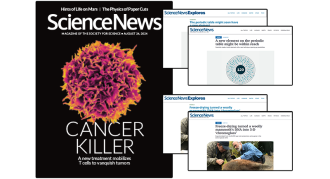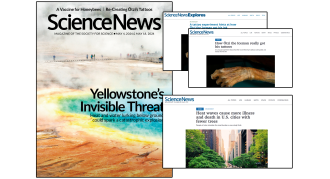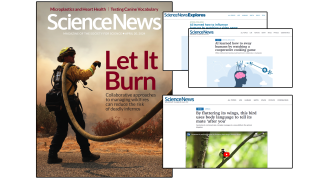Search Results
Investigating phenomena with SEPs
To investigate why some meteors create persistent trails, scientists filmed the New Mexico sky for two years, recording streaks of light. Use shooting stars as an example phenomenon to generate student interest, wonder and questions. Then, have students explore how this phenomenon was studied using Science and Engineering Practices, while evaluating the study’s design, limitations and possibilities for future research. Finally, have students search for another phenomenon that interests them and begin asking questions about it.
Egyptian hydraulics: Does this idea hold water?
How did the ancient Egyptians build the pyramids? It's an age-old mystery. A new study points to hydraulic engineering. But does this idea really hold water? Some experts in the field argue against new evidence being provided to support such claims. Learn how researchers use evidence to support claims while discussing the value of healthy skepticism in science.

Woolly Mammoth DNA and A New Element
Use news articles from the August 24 Science News issue to discuss a new possible element and learn how elements get onto the periodic table and practice what happens during transcription and translation while learning about recently analyzed woolly mammoth DNA.
Pairing up to create proteins
Scientists studied ancient woolly mammoth DNA that had been freeze-dried in place, preserving it and retaining its shape. The researchers adapted a technique for studying the structures of chromosomes within a nucleus to determine which genes were turned on and off in the mammoth genome. In this activity, students will review what happens when genes are turned on by completing exercises that illustrate hypothetical DNA base pairing and simplified examples of transcription and translation.
Turning genes on and off
Scientists have been able to study genetic activity in an ancient woolly mammoth’s DNA, thanks to a new method. Learn about the research study and the preservation of the DNA while thinking through the implications of having certain genes turned on or off.
When atoms collide, new elements arise
Take note — there could soon be a new element on the block. By smashing atoms together, scientists have been expanding our periodic table of elements beyond what occurs in nature. Learn how scientists create them while answering questions and discussing how such innovations may help us in the future.

Data Literacy and The Iceman’s Tattoos
Integrate recent articles from the May 4 & 18 issue of Science News to have students discuss how graphs can promote misinformation and learn about unconventional approaches to tattooing while answering experimental design questions.
Covering data literacy
Students will work in groups to answer questions about graphs and data visualizations. Then, they will discuss data literacy and how graphs can promote misinformation
How Ötzi Got His Ink
When Ötzi, the mummified iceman, was discovered in 1991, researchers thought they knew how he got his ink. But new findings cast doubt on those assumptions. Learn about unconventional approaches to tattooing and answer experimental design questions, such as the importance of sample size to a scientific study and the difference between quantitative and qualitative evidence.

AI Influence and Organism Observations
Use two articles from the April 20 issue of Science News to have students think critically about methods of training AI that can teach them how to influence human behavior and have students conduct observations of an animal and reflect on what they can learn about animal behavior.
Organism Observations
Students will observe animal behavior via live camera feed and reflect on their observations. Then they will learn about how animal behaviorists use camera traps and field observations to infer meaning from animal behaviors.
Overcooked & Outplayed
In this study, humans and AI worked together to score the win. But it’s the human partners that got played. Learn how some methods for training AI can also teach AI to influence human behavior, then answer questions about the potential implications of a future world in which AI sways human behavior.